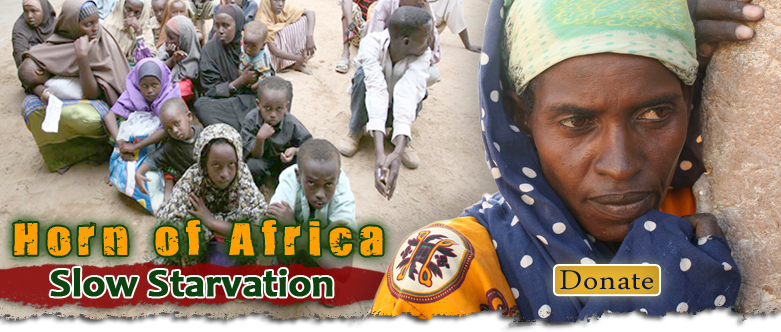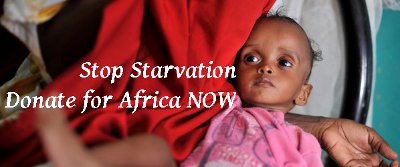UNICEF urgently requires US$31.8 million for the next three months to provide humanitarian support to crisis affected children and women in Somalia, Kenya, Ethiopia and Djibouti
The Horn of Africa is facing a severe crisis due to the convergent effects of the worst droughts in decades, a sharp rise in food prices, and the persistent effects of armed conflict in Somalia, which has combined to trigger one of the sharpest refugee outflows in a decade to Kenya and Ethiopia. Over ten million people are at high risk including 2.85 million persons in Somalia, 3.2 million in Ethiopia and 3.5 million in Kenya.
• Urgent life-saving actions are needed to prevent the deaths of an estimated 480,000 severely malnourished children in drought affected Kenya, Somalia Ethiopia, and Djibouti. A further 1,649,000 children are moderately malnourished. All crisis affected persons are at high risk of disease outbreaks including measles, acute watery diarrhoea and pneumonia
• Full funding will ensure that vulnerable women and children will:
– receive treatment for severe acute malnutrition through provision of Ready- to-Use-Therapeutic Food at community level or at therapeutic feeding centers
– gain access to clean water through the repair of pumping stations, digging of boreholes, chlorination of water sources and water trucking
– receive vaccines against measles, polio and other deadly diseases
– resume education through temporary learning spaces and school-in-a-box kits
Find more information here:UNICEF_Humanitarian_Action_Update_-_Horn_of_Africa_crisis_-_8_July_2011
How can you help?
SHARE:
1. Share this article on your social networking profiles and Blogs (Facebook, Twitter, Google+, Tumblr, etc.)
2. I’ve made/found a few banners you can use for your Blogs and Websites:

<a href=”http://www.supportunicef.org/site/pp.asp?c=9fLEJSOALpE&b=7542627″><img alt=”” src=”http://www.unicef.org/images/hp_banner_horn_africa.gif” title=”horncrisis” width=”120″ height=”80″ /></a>

<a href=”http://www.supportunicef.org/site/pp.asp?c=9fLEJSOALpE&b=7542627″><img src=”http://the-turning-point.com/wp-content/uploads/2011/07/78974.jpg?w=300″ alt=”” title=”78974″ width=”300″ height=”127″ class=”alignleft size-medium wp-image-3553″ /></a>

<a href=”http://www.supportunicef.org/site/pp.asp?c=9fLEJSOALpE&b=7542627″><img src=”http://the-turning-point.com/wp-content/uploads/2011/07/banner3.jpg” alt=”” title=”banner3″ width=”200″ height=”151″ class=”alignleft size-full wp-image-3552″ /></a>

<a href=”http://www.supportunicef.org/site/pp.asp?c=9fLEJSOALpE&b=7542627″><img src=”http://the-turning-point.com/wp-content/uploads/2011/07/banner2.jpg?w=300″ alt=”” title=”banner2″ width=”300″ height=”125″ class=”alignleft size-medium wp-image-3551″ /></a>
This is another great article about the crisis in the Horn of Africa:
“My wife was nine months pregnant when we started the journey,” says Isha’s father, Noor Miyo. “On the way, we suffered. We had to pass through Al Shabab checkpoints, and they took whatever we had.”
Adds the baby’s mother, Nurto Manoor: “I went into labour on the first night after we arrived here. They rushed me to the hospital. Thanks to that, my baby is alright now, but I am worried about her future. Maybe I won’t have anything to give her.”
Overcrowded conditions
Ms. Manoor’s concern is shared by many inside and outside the three camps in Dadaab. In recent months, due to severe drought, high food prices and on-going conflict, a huge number of Somali children and their families have fled across the border and sought refuge in the camps.
The Dadaab camps were built for 90,000 people some 20 years ago, but now they house about 380,000 residents. At least another 20,000 are still waiting to be registered.
“These women and children have gone through many hardships,” says UNICEF Regional Director for Eastern and Southern Africa Elhadj As Sy, who visited Dadaab this week. The refugees have clearly expressed what they need, including food, water and other basics to help them survive, notes Mr. As Sy.
“At the same time,” he says, “we also realize that there are hundreds more coming in every day, and that’s not sustainable, even if all the necessary things were done.”
VIDEO: 11 July 2011 – UNICEF’s Kun Li reports on a sharp increase in the number of severely malanourished Somali refugee children struggling to survive in camps in Dadaab, north-eastern Kenya.
Lack of resources
At a hospital ward for severely malnourished refugee children, Amina Ali weeps at her son’s bedside. Ms. Ali is also one of the recent arrivals in Dadaab. Over the past few years, she has lost 6 of her 10 children. Now she is worried that she may lose another one.
“He has diarrhoea and severe dehydration,” says Abdishakur Mohamed, a paediatrician working in the ward. “He has been sick since they arrived.”

Newly arrived refugees from Somalia wait to be registered and receive food aid in Dadaab, north-eastern Kenya. © UNICEF/NYHQ2011-0995/Holt
Across the camps, feeding programmes have been overwhelmed by a sharp increase in the number of malnourished children. Among the admissions, nearly half are newly arrived. One recent screening at Ifo, one of the camps in Dadaab, showed a 24 per cent malnutrition rate for children under the age of five among the new arrivals. According to the screening results, 9.4 per cent of the children were severely malnourished.
Mothers need counselling
And mothers and children in the camps face other challenges beyond the shortage of resources and services.
“When the mothers go home with food rations, they often find it difficult to prepare a proper meal because of a lack of access to clean water and firewood,” explains UNICEF Nutrition Officer Olivia Agutu.
Ready-to-use therapeutic foods such as Plumpy’nut, a nutritious peanut-based paste, are given to sick children, says Ms. Agutu. “But in many cases, they have to be shared by the entire family,” she adds. “The mothers definitely need counselling, especially the new arrivals. Many of them may not know how to detect the early signs of malnutrition.”
No room for school
The education needs of refugee children are also immense. Many of them have to take their classes in the open, because the proper schools in Dadaab are too crowded to accommodate them. Child-friendly spaces in the camps are under similar constraints.
There is an urgent need for schools here, so that children can have a safe space for learning and recreation – a place where they can forget about the harsh realities of life in the camps.
“While we should do everything possible to take care of the needs of those who are already here,” says Mr. As Sy, “the same level of effort needs to be put in places where people are coming from, so that they should not need to be on the move.”
In a move that could help to ease pressure on the existing camps, the Government of Kenya today announced that it will soon open a new camp extension in Dadaab for Somali refugees fleeing conflict and drought.


No Replies to "Please Help! Child Survival At Stake In Eastern Africa"